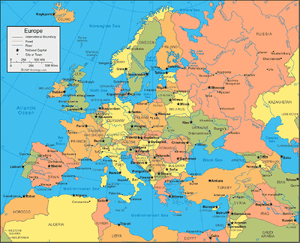Russo-American War
Russo-American War Edit
Edit
The Russo-American War, often dubbed World War III or the Soviet Conflict, was a conflict between the United States, allied with NATO, and the Soviet Union. It lasted under a year, starting on October 
 Added by The Pod
Added by The Pod. That all changed on October 19th, 1962. President John. F. Kennedy was visiting New York City to give a public speech about the escalating Vietnam Conflict. While there, a group of Soviet sleeper agents had made their way into the U.S on a mission to crush morale and bring the U.S out of Vietnam. The group entered to the crowd and opened fire. Over 100 people were killed in the massacre, including President Kennedy. The Soviet group was compromised by C.I.A officials and presidential guards and executed. The attack had shocked the nation, with a public uproar for war against the Soviets. Now President Lyndon Banes Johnson, under pressure from a devasted public, signed a declaration of war on the Soviet Union on October 20th, 1962. The Soviets hadn't expected a declaration of war from the U.S, for they felt America had not wanted a direct conflict. The Soviet Union then began to assemble its troops and await U.S attack.
After declaration, the U.S sent troops from home as well as shifted troops out of Vietnam and Korea into West Germany. The Vietnam Conflict had been escalating, but departure of U.S troops brought the conflict to a stand-still. In West Germany, 4 million U.S troops readied for invasion and awaited aid from NATO. The armies of France, the United Kingdom, Canada, Belgium, the Netherlands, West Germany, Spain, Italy, and Greece had sent a total of 6 million troops to the German front. By November 7th, NATO had formed an allied army of over 10 million men. After days of airstrikes from NATO air forces, the land forces moved to East Germany. However, when troops crossed into East Germany, they violated the Warsaw Pact. The Soviets gathered men from across the state and piled up a force of 8 million men and marched west to meet the NATO troops.
The war began as a stalemate. Neither side could land a sufficient blow, for both sides used similar tactics and technology. NATO troops won a decisive victory at the Battle of Bratislava, pushing Soviet troops back. Then, NATO advancement pushed the Soviets into Belarus. At the 1st Battle of Minsk, Soviet lines held up and drove back the NATO offensive. NATO troops felt their heaviest loss so far in the war, over 900,000 casualties. General Richard Ryderson, the U.S commander of NATO forces, urged a second attack, despite criticism. At the 2nd Battle of Minsk, using swift tactics with devasting bombardment, the Soviets were pushed back evern further into their territory. The Soviets, outnumbered and outengineered, were decimated by NATO attacks. Ryderson lead the assault at the Battle of Kiev. NATO troops pushed through Soviet lines once again and opened a direct path to the heart of the USSR, Moscow. Running out of options, Primier Nikhita Kruschev ordered the use of nuclear weapons on NATO forces. After disregarding nuclear law and sanctions, the Soviets launched a nuclear warhead at the frontmost NATO lines in the Ukraine.
The blast severly crippled the NATO force, with over 5 million dead. The attack sparked outrage from the world. The U.S, feeling the Soviets had gone too far, decided to crush enemy opposition and finally end their conflict with the USSR. On July 6th, President Johnson ordered a nuclear bombardment, 5 nuclear missiles would be launched at Soviet territory. Within hours, nuclear obliteration had hit the USSR in major cities, including St.Petersburg. Horrified at the loss of over 10 million people, and still recovering from the losses on the frontlines, the Soviet Union gave into NATO demands and called for an end to the war.
On July 8th, several world leaders met at Moscow to formally end the Third World War. The treaty forced the Soviet Union to dissolve and to never adopt the principle of communism again. It cut Soviet territory down and ordered Soviet influence to be brought out of Europe and Asia, this informally ending the Vietnam Conflict. It also demanded the Soviet Union to pay reparations to NATO countries, as well as de-scale its military to one/ tenth its size. Finally, it ended the Soviet nuclear program, and all nuclear weapons were to be disposed of or sent to NATO countries. The treaty brought about a new change in world order. Nuclear weapons had new laws placed on them, as well as more severe sanctions. New European and Asian nations emerged, such as Poland, Czechoslovakia, Belarus, Ukraine, and Kazakhistan. The dissolved USSR became the New Russian Republic, and became a democracy.

Δεν υπάρχουν σχόλια:
Δημοσίευση σχολίου